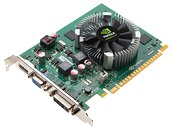Thursday, April 20th 2017

NVIDIA Readies the GeForce GT 1030 to Compete with Radeon RX 550
With the Tuesday (18/04) launch of the Radeon RX 550 at US $79, the market for IGP-replacement discrete GPUs sprung back to life. NVIDIA is preparing to address the market with the new GeForce GT 1030 graphics card, based on its "Pascal" architecture. The SKU will be based on the new 14 nm "GP108" silicon, and could feature up to 512 CUDA cores, and up to 2 GB of GDDR5 memory across a 128-bit wide interface.
With tiny board and electrical footprints, one can expect the chip to rely on the PCI-Express slot entirely for its power, and come in low-profile and fan-less designs. It could feature an up-to-date I/O, including HDMI 2.0b and DisplayPort 1.4, which its predecessor, the GT 730 lacks. The company could formally announce the GT 1030 around mid-May, 2017.
Source:
Expreview
With tiny board and electrical footprints, one can expect the chip to rely on the PCI-Express slot entirely for its power, and come in low-profile and fan-less designs. It could feature an up-to-date I/O, including HDMI 2.0b and DisplayPort 1.4, which its predecessor, the GT 730 lacks. The company could formally announce the GT 1030 around mid-May, 2017.

37 Comments on NVIDIA Readies the GeForce GT 1030 to Compete with Radeon RX 550
Intel HD 630 has slightly better performance than Nvidia GT 635 and Radeon HD 7570.
- 128 shaders at 1500MHZ (vs. 512 at presumably ~1200?)
- 768MB GDDR3 memory (vs 2GB GDDR5)
- An effective 2160MHZ over a 384-bit bus (vs. an effective speed of 6GHZ+ over a 128-bit bus)
A surprisingly close comparison, but yeah, it'll run Crysis, probably very comfortably, although possibly not maxed out at >1080p :DBoth RX550 and GT1030 are not gaming cards. They're IGP replacements for systems without such "luxury" (Ryzen, Intel HEDT and so on). That's something we haven't seen since Kepler.
On the NVIDIA side we can basically expect passively-cooled (or almost noiseless), single-slot cards using under 30W. It's hard to say what AMD will offer, but if it's on par with the Radeon Pro they make for Apple, it'll be a decent competitor.
Just the simplest example: GT730 supports a up to 3840x2160, so it could struggle with modern multi-monitor setup. GTX1050 supports 4 times as much.
Also the efficiency improved a lot. You can find a passively cooled GT730, but it could get to high temperatures under load.
Based on what other Pascal cards can do, the GT1030 could be passively cooled by default (and really cool with that ;)). This is important.
Basically, we're getting back to a point where a "productivity" card can look like it used to 20 years ago:
It's obviously a single-slot card and the heatsink is covering memory (most cards didn't have that).
By comparison, this is a passively cooled GT730:
I remember only one single-slot passive card from GT7xx era - Zotac GT 710. AFAIK it needed a decent air circulation.
X1040?Honestly, hard to say.
AMD decided to revive a whole lineup of cheap Radeons for their Ryzen lineup - basically like it used to be before IGP became ubiquitous.
We'll see what will happen. I don't think Intel will remove IGP from it's cheaper models, so the market for such cards will be much smaller than it used to.
But think about it. Some of these cards will be designed to work with high-end CPUs (Ryzen 7, Intel HEDT) in productivity rigs.
I think we could see some "pro" models - with relatively weak chips, but good features and high quality (also for the cooling solutions).
The Radeon Pro 460 in latest MacBook Pro can support 2x5K or 4x4K (beside the built-in 2880x1800). Check if you desktop gaming monster can do that. :)
I think we could use a passively cooled, single-slot card that can support multiple high-resolution monitors for some CAD or graphic editing environment (Matrox-style :)). That should sell well - even for a fairly large price.